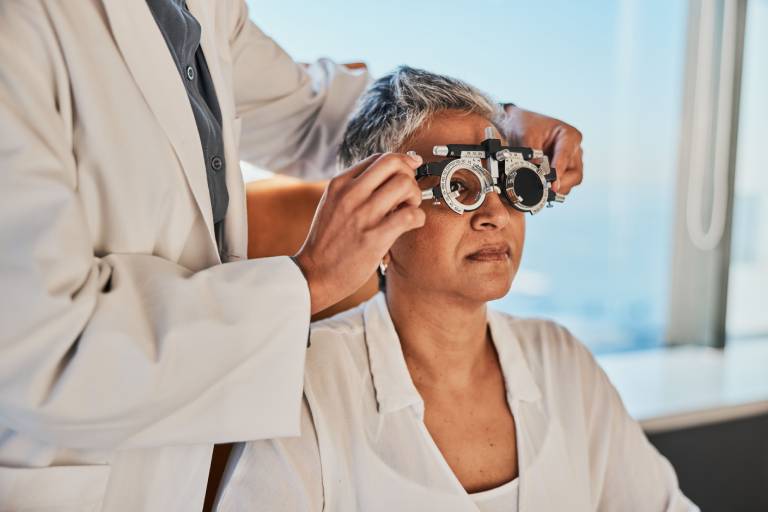By the age of 75, roughly 1 in 3 people in the United States will have some form of age-related macular degeneration (AMD). Even more concerning, about 1 in 4 of those individuals will develop a vision-threatening, late-stage form of the disease.
But what exactly is macular degeneration? How does it impact vision, and what can be done to prevent or treat it? This guide will help you understand it. Let’s find out more about the condition, its causes, symptoms, and available eye treatments.
What Is Macular Degeneration?
Macular degeneration is a common eye condition that primarily affects the macula, a small but critical part of the retina. The macula is responsible for sharp, central vision. It is essential for activities like reading, driving, and recognizing faces.
There are two main types of macular degeneration:
1. Dry (atrophic) Macular Degeneration
The most common form, accounting for about 80% of cases, dry (atrophic) macular degeneration progresses gradually as the macula thins over time. It leads to mild to moderate vision loss.
2. Wet (neovascular) Macular Degeneration
A more severe but less common type, wet (neovascular) macular degeneration occurs when abnormal blood vessels grow under the retina and leak fluid or blood. It causes sudden vision loss.
Also Read: Refractive Errors: Understanding Myopia, Hyperopia, Astigmatism, and Presbyopia
Causes of Macular Degeneration
Several factors contribute to the development of macular degeneration. Some of them are as follows:
- Age is a critical factor. Most cases occur in individuals over 60 years old.
- A hereditary component exists. In fact, researchers have identified specific genes linked to AMD.
- White individuals have a higher risk compared to other races.
- Tobacco use significantly increases the likelihood of developing AMD.
- Being overweight may accelerate the progression of AMD to its severe stages.
- Cardiovascular diseases, affecting the heart and blood vessels, may heighten the risk.
Symptoms to Watch For
The macula sends visual information to the brain. When it becomes damaged, your brain struggles to process what your eyes see. The following symptoms of macular degeneration often emerge as the disease progresses:
- Difficulty seeing in low light
- Blurred or distorted vision
- Changes in color perception
- Straight lines appearing wavy or curved
- Dark or blank spots in your central vision
If you notice these signs, especially distortion in straight lines, consult an eye care provider immediately.
How Is Macular Degeneration Diagnosed?
Macular degeneration often develops without noticeable symptoms in its early stages. So, annual eye exams are crucial for early detection. Eye care providers use several tests to diagnose the condition:
- Amsler Grid Test identifies blurry, wavy, or broken lines in a grid.
- Dilated Eye Exam uses eye drops to widen pupils for a detailed examination of the retina and macula.
- Fluorescein Angiography tracks a dye injected into your bloodstream to identify blood vessel leakage in the eye.
- Optical Coherence Tomography (OCT) produces detailed images of the retina and macula using light waves.
- OCT Angiography (OCTA) is a non-invasive method to visualize blood flow in the eye.
Treatment Options
There’s no cure for macular degeneration. But early intervention can slow its progression and alleviate symptoms.
For dry macular degeneration, the AREDS and AREDS2 studies recommend a mix of vitamins and minerals to slow the disease. Ingredients include Vitamin C, Vitamin E, zinc, copper, lutein, and zeaxanthin.
On the other hand, in the case of wet macular degeneration, anti-VEGF injections can block a protein that promotes abnormal blood vessel growth.
Also, Photodynamic Therapy (PDT) combines a light-sensitive drug and laser to destroy leaking blood vessels. Laser photocoagulation uses a laser to seal leaking vessels, though this is less common today.
Having said that, symptoms can return despite treatment. So, ongoing monitoring is essential.
Also Read: Role of Nutrition in Eye Health: Foods for Better Vision
Preventing Macular Degeneration
Adopting healthy lifestyle habits can lower your risk of developing macular degeneration:
- Consume foods rich in omega-3 fatty acids, lutein, and zeaxanthin, such as fish, leafy greens, and eggs.
- Exercise regularly to maintain a healthy weight and reduce cardiovascular risk.
- Quit smoking to reduce the likelihood of developing AMD.
- Wear sunglasses with UV protection to shield your eyes from harmful rays.
Also Read: 5 Eye Health Tips Essential for Optimal Vision
Conclusion
Macular degeneration is a leading cause of vision loss, especially among older adults. Understanding its causes, recognizing symptoms, and exploring treatment options can help you take proactive steps to protect your vision.
Early diagnosis and treatment can make a significant difference in preserving your sight. So, if you notice changes in your vision or fall into a high-risk category, schedule an appointment with an eye care professional at Shree Ramkrishna Netralaya, one of the best eye hospitals in Mumbai.

